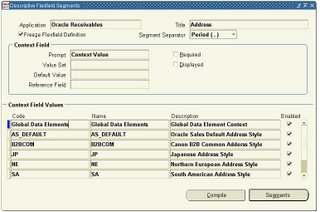Oracle Applications let you enter customer, supplier, bank, check, and remit–to addresses in country–specific formats. For example, if you have customers in Germany, you can enter German addresses in the format recommended by the Bundespost, or you can enter addresses for customers in the United Kingdom in the format recommended by the Royal Mail.
This is done by using descriptive flexfields to enter and display address information in the appropriate formats. The flexfield window opens if the country you enter has a flexible address style assigned to it, which lets you enter an address in the layout associated with that country. If there is no address style associated with the country, Oracle Receivables uses the standard address format.
Oracle iStore for example also uses these formats to output the address for example in the checkout pages. An address style tells Oracle Applications how to format and arrange the address fields so that they best suit the address entry requirements of a particular country. Many countries can use the same address style, although a country can only use one address style at a time. You assign address styles to countries using the Countries and Territories window. You can assign one of the address styles provided or you can create your own.
You can create your own by using the using the “Application Developer” responsibilities and selecting the “Flexfield” > “Descriptive” > “Segments” menu. Here you can search for Application: Oracle Receivables & Title: Address, this will give you the Descriptive Flexfield Segments who are taking care of the address style in Oracle.
 By using Segments you can add or remove valuesets to the address style. This will result in a new style for input and output of your addresses and will result for example in changes in the Oracle iStore checkout pages.
By using Segments you can add or remove valuesets to the address style. This will result in a new style for input and output of your addresses and will result for example in changes in the Oracle iStore checkout pages.
1 comment:
Hi Johan,
Have you implemented the set of oracle instore in jdeveloper.If you have please tell me the procedure.please post the post the procedure in your blog.
thanks
Indian
Post a Comment